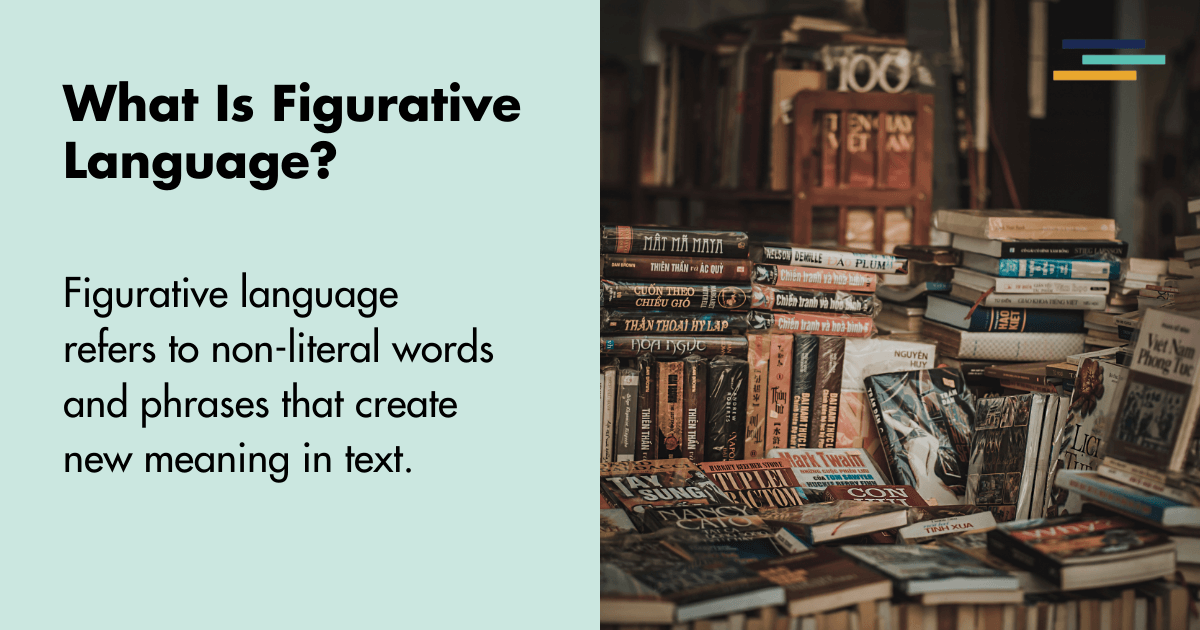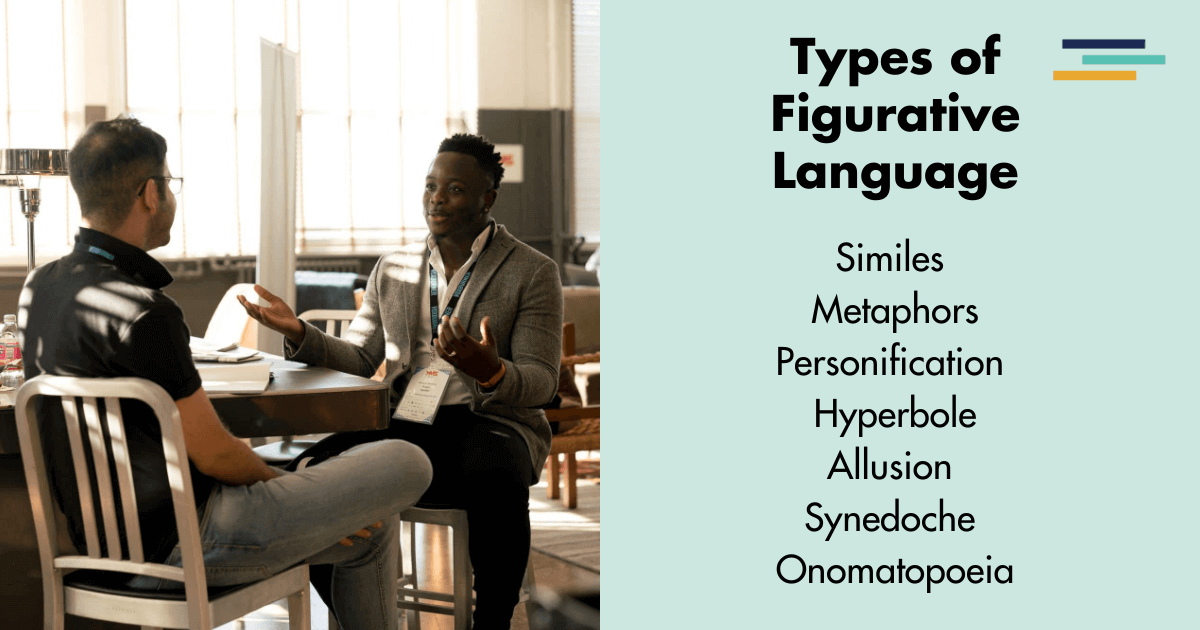
You’ve probably heard the term figurative language, but what does it actually mean?
Valid question, but fear not because I’ve broken down the seven different kinds of figurative language, provided some examples for each one, and wrapped up with my top three tips for using good figurative language.
Let’s get stuck in.
What is Figurative Language?
According to Merriam-Webster, “Figurative language refers to words or phrases that are meaningful but not literally true.”

The 7 Different Kinds of Figurative Language
There are many types of figurative language you can use to enhance your writing, and each one serves a slightly different purpose. Below, I’ve included a list of the different kinds of figurative language out there and a definition of what they are.
Once you understand each category of figurative language, we’ll look at some examples so you can really bed the knowledge in.
Let’s start with one of my favorite kinds of figurative language, similes
Similes
You use similes when you want to compare two things that rarely go together, and you split them up with the words “like” or “as” to draw the reader’s attention to the comparison.
The purpose of a simile is to create a vivid image in the reader’s mind. When writers use similes, they’re often taking complex or abstract ideas and expressing them in ways readers understand.
This technique of taking something nebulous or unfamiliar and comparing it with something we encounter often in our daily lives can also create unique descriptions, add emphasis, or set a particular tone.
Metaphors
Metaphors confused me for the longest time. I never really understood what they were, so I couldn’t explain them clearly. Then one day, it clicked.
Much like a simile, a metaphor makes a comparison between two different things that rarely go together. The crucial difference between a simile and a metaphor is that readers know a simile is a comparison because of the words “like” and “as.”
With a metaphor, you’re effectively told that one thing is something else, which makes the comparison sound like reality. The purpose of a metaphor is to create “literal comparisons” that lend your writing a creative and poetic flourish. You can use metaphors when you want to add a deeper meaning to your writing.
Let’s get nerdy for a second (because why wouldn’t you) and chat about the different metaphors you can use. They include:
- Direct Metaphors: Clearly state that one thing is another without using “like” or “as”
- Implied Metaphors: Suggest the comparison without specifying it
- Extended Metaphors: Develop the initial comparison over several sentences or throughout an entire work
- Dead Metaphors: Commonplace comparisons that have lost their original vividness because of overuse
- Mixed Metaphors: Combine elements of multiple metaphors, often creating a jarring or humorous effect
Yep. That’s a lot of metaphors right there, but hopefully that’s helped clarify what they are.
Personification
Another favorite of mine.
When you use personification, you apply human characteristics to a non-living object or an abstract idea to create vivid imagery in the reader’s mind. This technique can make your writing more interesting when done well.
The purpose of personification is to enhance the reader’s ability to connect with the ideas you express because, by giving something abstract or inanimate some human characteristics, readers will instantly be able to picture it in their minds. Readers are used to interpreting human emotions, physical gestures, and intellectual attributes because they do it daily.
Using personification in this way helps make your writing relatable.
Hyperbole
We all know someone who speaks using exaggerated turns of phrase that border on the ridiculous and can be downright funny. This is hyperbole. You can use it in your writing if you want to create deliberate and obvious exaggeration, which can be more useful than you might think.
Writers often use this literary device to convey strong character emotion or an inflated sense of danger because, when used sparingly, hyperbole can work well in moments of high tension to really convey the stakes of what a character is going through.
Now you know what hyperbole is, you’ll spot it everywhere, not just in books. You’ll see it all the time in speeches, advertising, and marketing materials and in everyday conversation with your friends and family.
The purpose of hyperbole is to add drama, urgency, and sometimes humor to your prose, and these exaggerated moments can really resonate with readers.
Allusion
Allusion is when the author alludes to someone or something that exists in the world and is familiar to readers to make a point.
TV shows are renowned for their pop culture references, and this is perhaps the most well-known type of allusion out there. In these shows, the writers use pop culture references as a kind of shorthand to convey a message because most readers (even if they don’t know exactly what the pop culture reference is) will have heard of it.
The purpose of allusion is to use references to a well-known person, place, event, book, TV show, song, band, etc. to add layers of meaning to your writing.
Synecdoche
Synecdoche is when you use the word for one part of an item or object to refer to the whole item or object. You can also use it in the opposite way, using the word for the whole item to refer to a specific part of it. This will become clearer when we look at some examples later.
The purpose of synecdoche is to add depth, layers of meaning, and symbolism to your writing.
Onomatopoeia
The last type of figurative language we’re going to talk about is onomatopoeia.
This all relates to sound, and it’s when the word you use, when spelled phonetically, sounds the same as the noise you’re describing.
The purpose of onomatopoeia is to use sound to create atmosphere, enhance your imagery (a sound creates a vivid picture in the reader’s mind), and make your writing more engaging.

Figurative Language Example Sentences
Now we’ve covered what each type of figurative language is, let’s get the knowledge cemented in by looking at a couple of examples of each.
Simile Examples
- Ray Bradbury, The October Country: “The water made a sound like kittens lapping.”
- William Shakespeare, As You Like It: “The world is like a stage, and we are merely players.”
Metaphor Examples
- Dante Alighieri, Inferno: “I am the way into the city of woe.”
- William Goldman, The Princess Bride: “Her heart was a secret garden and the walls were very high.”
Personification Examples
- Margaret Atwood, The Handmaid’s Tale: [Referring to a garden] “It breathes, in the warmth, breathing itself in.”
- F. Scott Fitzgerald, The Great Gatsby: “But his eyes, dimmed a little by many paintless days under sun and rain, brood on over the solemn dumping ground.”
Hyperbole Examples
- L. M. Montgomery, Anne of Green Gables: “I must have died and gone to heaven.”
- William Shakespeare, Hamlet: “I could be bounded in a nutshell and count myself a king of infinite space.”
Allusion Examples
- Hercules (or Herculean): Often used to emphasize strength.
- Pandora’s Box: Describes big (and usually unexpected) consequences or a source of trouble.
Synecdoche Examples
- “Jack got some new wheels.”: This means Jack got a new car, but wheels can refer to part of the car or the entire car.
- “I can’t wait to get back out on the waves.”: Waves are a part of the ocean, but surfers refer to the entire ocean as waves.
Onomatopoeia Examples
- “Crash.”: The word crash sounds like the noise an impact makes.
- “Bang.”: The word bang sounds like the noise an explosion makes.

Tips For Using Good Figurative Language
Tip 1: Use Figurative Language with Purpose
When I first discovered these seven types of figurative language, I couldn’t wait to use them. And use them, I did. Everywhere. All the time. Too much.
As with any literary tool that draws attention to itself, use it sparingly. As discussed, similes can be super useful when you want to create a funny comparison, and metaphors are great if you want to add some poetic qualities to your writing. But less is more.
You can use all these tools to create a certain effect, and their effects are so well received because they’re unusual. They’re a fantastic way to avoid repetition, but the more you use them, the less effect they have, and the more repetitive they become.
If you’ve read any of my previous articles, you’ll know how important it is to avoid repetition because it bores readers. And bored readers are never good. They might just decide to pick up another book because yours can’t keep them hooked.
Tip 2: Match The Tone of Your Figurative Language to Your Genre
Whatever effect you’re trying to create, it’s best to match the tone of your figurative language to your genre.
If you’re writing a comedic or satirical book, or you write in a genre where readers expect humor (like romantic comedy or urban fantasy), then you can use your similes, metaphors, personification (or any other figurative language) to enhance the humor of the piece. But if you’re writing in crime, thriller, horror, or any genre with darker themes, experiment with making your figurative language dark as well.
Tone is so key for readers, especially those who don’t read outside their preferred genre. Don’t disappoint readers by striking the wrong tone.
Tip 3: Avoid Overuse and Cliches
Where possible, try not to use figurative language we’ve all heard before. We call these phrases cliches, and while they have their place (e.g., one of your characters has a habit of speaking using cliche figurative language), the use of cliches is another form of repetition. And you know how I feel about repetition (he repeats).
Instead, spend some time practicing your figurative language skills, and see if you can come up with fresh new ways of being figurative.
And finally, always remember that story comes first. Before worrying about the perfect piece of figurative language to use, it’s best to focus on:
- Creating engaging characters
- Penning an interesting plot
- Structuring solid settings
A tool like Fictionary helps you turn your draft into an interesting story readers love. So, with the right language and a strong narrative foundation, your writing can truly shine.


